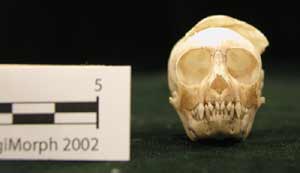Leontopithecus rosalia, the lion tamarin, is a South American or New World monkey. South American monkeys or platyrrhines comprise one of the two infraorders (Platyrrhini & Catarrhini) of anthropoid primates. They live exclusively in South and Central America, but their fossil distribution includes the Greater Antilles (MacPhee and Horovitz, 2002). The fossil record of platyrrhines extends back to the Deseadan or late Oligocene of Bolivia where they are represented by the genus Branisella (Takai and Anaya, 1996). Their presence in the New World is generally considered to be the result of a single dispersal event (Fleagle, 1999) near the end of the Eocene from the Old World, where all known basal anthropoids are found (Beard, 2002). Because South America was not connected with North America or Africa at the time, this dispersal must have involved rafting across some portion of the Atlantic. |
|
Once in the New World, platyrrhines diverged into a variety of forms ranging in size from the smallest living anthropoid (Cebuella) at ~110 grams to the howler monkeys (Alouatta) that reach 11 kg (Fleagle, 1999). This diverse radiation of primates includes 78 living species (Fleagle, 1999) in 16 genera, one of which is the only living nocturnal anthropoid, Aotus. Their diets and locomotor adaptations are diverse, though most are at least partly frugivorous and none are primarily terrestrial.
Although the adaptations of different genera are reflected in their craniodental anatomy, platyrrhines in general retain a cranial morphology more similar to primitive anthropoids from the Eocene and Oligocene of Egypt such as Catopithecus, Parapithecus, and Aegyptopithecus than do the living Old World anthropoids (Fleagle, 1999; Simons, 2001). The research for which these CT data were collected indicates that this primitive anthropoid cranial morphology included considerable cranial pneumatization via the paranasal sinuses.
Leontopithecus rosalia is a member of the Callitrichinae, a group of small platyrrhines that are distinctive in having claw-like bilaterally compressed fingernails. Leontopithecus is the largest member of this subfamily, with males and females averaging 620 g and 598 g respectively (Fleagle, 1999). Its skull is unique in possessing a pair of sphenoidal “pits” or “vacuities” (Hershkovitz, 1949; DuBrul, 1965; Hershkovitz, 1977), visible in ventral view, that pneumatize its basicranium.

About the Species
This female specimen, the skull juvenile (M1 not fully in place) was obtained from the Memphis Zoo. It died at approximately four months of age, and a section of the skull is cut away. The specimen was made available to The University of Texas High-Resolution X-ray CT Facility for scanning by Dr. James Rossie of Stony Brook University, courtesy of the Smithsonian Institution Division of Mammals. Scanning was funded by an NSF dissertation improvement grant to Mr. Rossie (#0100825). Funding for image processing was provided by a National Science Foundation Digital Libraries Initiative grant to Dr. Timothy Rowe of The University of Texas at Austin.
 |
anterior view |

 |
dorsal view |

About this Specimen
This specimen was scanned by Matt Colbert on 9 January 2002 along the coronal axis for a total of 310 slices. Each slice is 0.145 mm thick, with an interslice spacing of 0.145 mm and a field of reconstruction of 44.0 mm.

About the
Scan
Literature
Beard, K. C. 2002. Basal anthropoids. In (W. C. Hartwig, Ed) The Primate Fossil Record, pp. 133-149. Cambridge, Cambridge University Press.
DuBrul, L. E. 1965. The skull of the Lion Marmoset Leontideus rosalia Linneaus: A study in biomechanical adaptation. American Journal of Physical Anthropology 23:261-276.
Fleagle, J. G. 1999. Primate Adaptation and Evolution. San Diego, Academic Press.
Hershkovitz, P. 1949. Mammals of Northern Columbia. Preliminary Report no. 4: Monkeys (Primates), with Taxonomic Revisions of Some Forms. Proceedings of the United States National Museum 98(3232):323-427.
Hershkovitz, P. 1977. Living New World Monkeys (Platyrrhini). Chicago, University of Chicago Press.
MacPhee, R. D. E. and I. Horovitz 2002. Extinct Quaternary platyrrhines of the Greater Antilles and Brazil. In (W. C. Hartwig, Ed) The Primate Fossil Record, pp. 189-200. Cambridge, Cambridge University Press.
Simons, E. L. 2001. The cranium of Parapithecus grangeri, and Egyptian Oligocene anthropoidean primate. Proceedings of the National Academy of Sciences, USA 98:7892-7897.
Takai, M. and F. Anaya 1996. New specimens of the oldest fossil platyrrhine, Branisella boliviana, from Salla, Bolivia. American Journal of Physical Anthropology 99:301-317.
Links
Mammalian Species account of Leontopithecus rosalia (American Society of Mammalogists)
Leontopithecus rosalia on the Animal Diversity Web (University of Michigan Museum of Zoology)
Leontopithecus rosalia on Primate Info Net (Univeristy of Wisconsin, Madison)

Literature
& Links
Face slice movie:

Additional Imagery
 |

